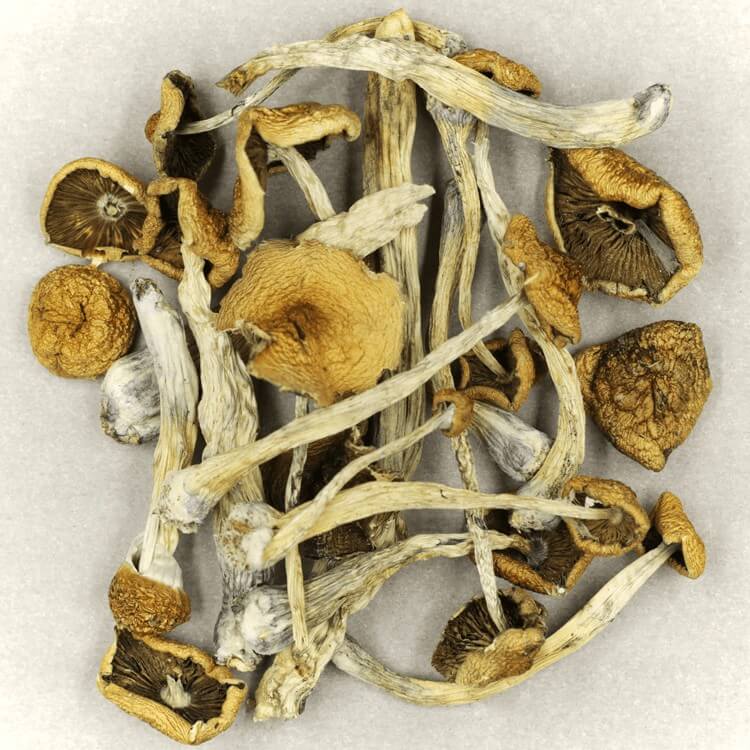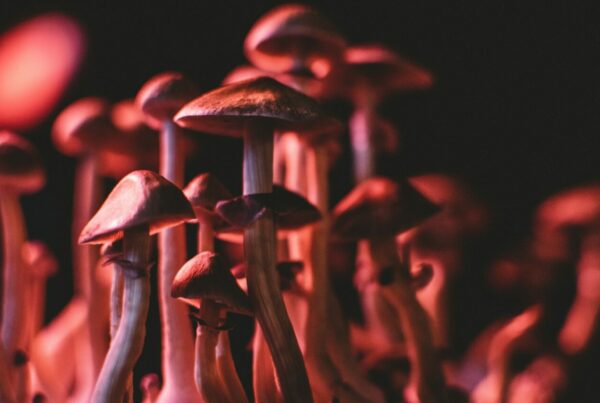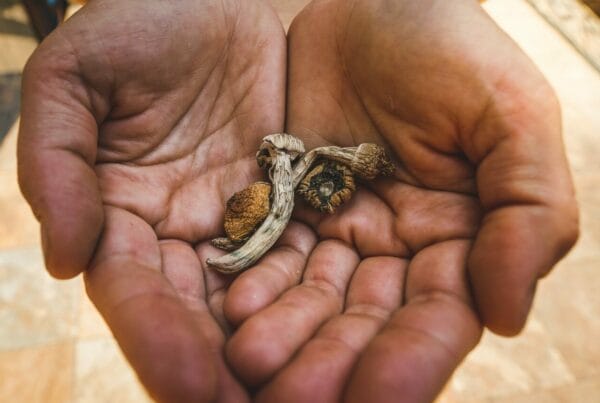Once, the strength of Psilocybe mexicana was thought to be mythical. But with the advancement of psilocybin research, this view has significantly changed. The psychedelic research community consistently uncovers its therapeutic benefits, leading to its gradual recognition in the medical world. Experts see this evolving field as promising and continually work towards determining safe dosage levels for medical purposes.
Key Takeaways
- Researchers are using innovative methods like liquid chromatography coupled with tandem mass spectrometry to measure the potency of mushrooms.
- Psilocybe Mexicana, along with other mushroom varieties, is subjected to clinical trials to evaluate its potential therapeutic applications.
- The genetic diversity in magic mushrooms is critical for developing an accurate dosage guide.
Psychedelic Mushrooms: Journey from Mystery to Scientific Discoveries
In the past, only a few conditions were believed to benefit from Psilocybe Cubensis. However, today, psilocybin is making impressive progress in revealing its concealed medical properties.
Experts are utilizing the potential of Psilocybe Mexicana and other potent strains for clinical trials and comprehensive research. Whether the studies are in vivo or in vitro, this strain efficiently provides the true effects and advantages of the fungus species.
Psychedelics Market Emergence
From being unknown to becoming public knowledge — continuous advancements and discoveries are increasingly garnering public attention, especially those seeking therapeutic solutions. Traditional treatments for mental health issues often fail to meet expectations, leading individuals to look for more trustworthy alternatives.
Here come magic mushrooms.
Patients grappling with mental health conditions are resorting to psilocybin, which has demonstrated potential in treating depression, alcohol addiction, anxiety, compulsions, tics, chronic pain, and more.
Currently, clinicians are investigating cutting-edge methods to precisely determine the optimal dosage for safe patient administration. In particular, a research team from the University of Texas has created a model to extract psilocybin and psilocin concentrations.
The potency of magic mushrooms can be clinically determined.
The Distinctive Features of Mexicana
Extensive studies have been conducted on Golden Teachers, Blue Meanies, and B-Plus. However, to expand our comprehension of secure magic mushroom consumption, there is a need to investigate other species.
The Mexicana species has emerged as a preferred subject for research. This is not only because it is one of the oldest species but also because its relatively mild potency increases its likelihood of complying with medicinal drug standards.
Despite the Mexican strain’s potency being less intense compared to other species, it can still provide the same effects as more conventional strains. As microdosing gains increasing popularity among patients, this strain proves to be an excellent option.
It possesses steady levels of psilocybin and psilocin, comparable to other strains. So, what makes it a preferable choice over other similar strains? Its historical and anthropological significance provides the answer.
Delving Into a Rich “Mexican” History
During ancient times, psilocybe mexicana naturally thrived in moss. These psilocybin mushrooms were highly respected by native people for their varied uses, often associated with mystical or supernatural occurrences.
Let’s focus on Mexican mushrooms. The first recorded usage of these shrooms dates back to over 2000 years ago, by the indigenous people of North and Central America. The Aztecs, an ancient ethnic group, referred to these mushrooms as the “food of the Gods,” or “teonanácatl” in their native language.
If the Aztecs were present today, they would attest to the transformative, emotionally potent, and mentally stabilizing effects of the Mexicana—even without comprehending these modern terms.
Despite different cultivation techniques, this mushroom has successfully retained its natural psilocybin concentrations, which attests to its authenticity. This authenticity is a universally accepted standard that both researchers and psychedelic research institutions deeply value.
Innovative Approaches to Psilocybin Content and Potency Testing
A team of ten researchers from the University of Texas at Arlington and other research institutions introduced a new method for testing the potency of psychoactive compounds in mushrooms. This novel B measurement pattern merges liquid chromatography and tandem mass spectrometry.
Here are a couple of innovative techniques:
- Liquid chromatography is a technique used to separate and analyze chemical mixtures. In this context, it is employed to identify active chemicals in mushrooms. This method involves passing a liquid sample through a column filled with a stationary solid material. The different chemicals in the sample interact distinctively with the stationary and mobile phases, leading to their separation at varied rates as they traverse the column.
- Spectrometry is a study that explores the interaction between matter and electromagnetic radiation across different wavelengths. It identifies and quantifies substances based on the unique wavelengths of light that their molecules absorb and scatter. This process enables the identification of the electronic, vibrational, and rotational states of the substance.
This method was employed on five strains of magic mushrooms, where researchers found that the average total levels of psilocybin and psilocin across these strains ranged from 0.879 to 1.36. These concentrations exceeded numerous other strains, including Bull Run and Cambodian. The researchers ensured the accuracy of their study by cross-checking their findings with results from independent labs.
The congruence in results between the two labs further reinforced the credibility of their testing process in accurately gauging the potency of the mushrooms.
If confirmed by experts, this could add a new set of methods to the existing toolkit for testing psychedelic strength, acting as an extra safety feature to avoid inaccurate dosage determinations.
Expansion of Research to Additional Species
Extending research to other species can be advantageous. It can improve our knowledge of the health benefits linked to different strains and provide foundational data on the effects of less potent mushrooms.
Moreover, it can help in enlightening individuals about the impact of different dosages on the psychedelic experience. By juxtaposing Mexicans with more potent strains like Psilocybe Cubensis, researchers can identify how different concentrations of active compounds can alter therapeutic outcomes.
For example, the Blue Meanies strain generates more potent hallucinogenic effects, which could potentially be useful in treating conditions such as depression. In contrast, strains with lower potency are more suitable for microdosing or subtler applications like mood enhancement or focus improvement.
The Role of Genetic Diversity in Safer Treatments
It’s not widely known that different cultivars or varieties have distinct genetic profiles and
Psychedelic mushrooms differ greatly in strength, composition, and effects. This diversity allows healthcare providers to select the most suitable variant for specific medical applications and adjust doses to meet individual requirements, thus reducing risks and maximizing benefits.
Take, for instance, the Psilocybe Semilanceata (Liberty Caps) or Psilocybe cyanescens. These have distinctive alkaloid profiles that could be beneficial in managing anxiety. In contrast, certain synthetically grown mushrooms might be better suited for addressing substance addiction or compulsive behaviors. This range provides the opportunity to develop personalized treatments with enhanced safety and efficacy.
It can be inferred that the genetic diversity in psychedelic mushrooms, when paired with innovative techniques for evaluating strength and identification, is key in the development of safer medical treatments.
Enhanced Safety in Medical Use
Let’s contemplate the potential benefits of safer dosage practices.
- Decreased overdosing incidents: Accurate dosing alleviates users’ concerns about overdose. This also suggests that product labels should be clearer to avoid consumer misunderstanding.
- Increased predictability: With precise dosing, individuals can better anticipate the effects or experiences during their psychedelic journeys. This could lessen overwhelming sensations and anxiety, leading to improved patient satisfaction.
- Uniform measurement: Accurate dosing can help establish a standard metric, enabling people to easily refer to charts for potential effects.
Experience the Advantages of Accurately-dosed Shrooms with State-of-the-art Potency Tests | Order Magic Mushrooms Online from Get Magic Mushrooms Canada
If these two progressive techniques continue, you can avoid unforeseen effects. Pair this with smart online shopping at Get Magic Mushrooms Canada. We offer dried mushrooms that deliver a calm, soothing psychedelic experience without intense psychoactivity. Buy psychedelics online in Canada via Get Magic Mushrooms Canada.
Frequently Asked Questions
Are Big Mexicans and Psilocybe Cubensis the same?
No, Big Mexicans and Psilocybe Cubensis are distinct mushroom strains, and it’s crucial not to confuse them. Big Mexicans have a higher compound isolation, ranging from 0.5% to 1%, making them significantly more potent.
than Psilocybe Cubensis. Take note, their physical characteristics vary too: the first often exhibits a bell-shaped cap, whereas the latter is typically conical.What’s the highest concentration found in Mexican mushrooms?
The concentrations of both psilocybin and psilocin in Mexican mushrooms can reach a maximum of 0.25%. Although these levels are comparatively low, similar to the Golden Teacher strain, they are capable of inducing profound psychedelic experiences, which could potentially confer health benefits.
What’s the recommended safe dosage for medical purposes?
Commonly, a dosage between 1 to 2 grams is recommended. However, this can fluctuate based on elements such as the method of consumption, individual metabolic rates, and the specific potency of the mushroom strain. Some individuals opt to consume sub-threshold doses ranging from 0.05 (50mg) to 0.025 grams (250mg) to minimize the psychedelic impact.





